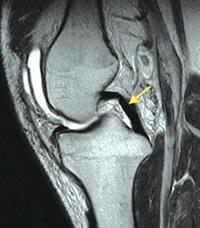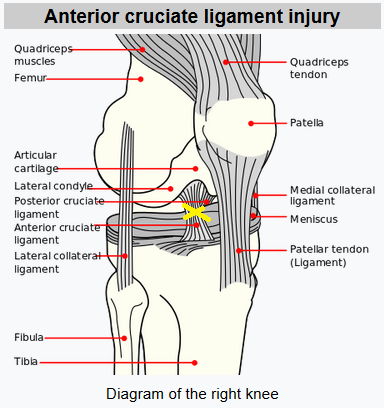nalco group
bone, muscle & joint pain physio
BOOK NOW / WHATSAPP ABOUT YOUR PAIN OR INJURY
- ORCHARD 400 Orchard Road #12-12 Singapore 238875
- TAMPINES 9 Tampines Grande #01-20 Singapore 528735
- SERANGOON 265 Serangoon Central Drive #04-269 Singapore 550265
Anterior Cruciate Ligament (ACL) Injury & Tear KNEE Physio
So knee anterior cruciate ligament (ACL) injuries and tears are very common sports and exercise injuries...but did you know that "only" 20% of knee anterior cruciate ligament ACL injuries are caused by direct contact?
This means that 80% of the time, our ACLs are hurt and damaged by non-contact trauma!

Our knee anterior cruciate ligament is one of the four "big" ligaments of the knee, and the ACL sits deep inside the middle FRONT portion of the knee (that's why it's anterior).
It's a really thick band (as thick as a pencil!) and about 2 cm long (about the length of an almond nut). It's durable and strong too, because the ACL's key job are:
- controlling the stability of the knee
- preventing the shin (bone below the knee) from sliding too far forward beyond the knee
- preventing over-twisting of the knee
WHAT IS AN ANTERIOR CRUCIATE LIGAMENT TEAR?
Anterior cruciate ligament tears happen when the knee ACL ligament is stretched beyond what it physical can stretch.
Most of the time, these ACL injuries happen either because
- the knee bent backwards too much (extreme kneeling)
- the knee twisted awkwardly
These cause:
- mild injury where only a few fibres of the ACL ligaments are strained ("strain")
- partial tears happen when 10-75% of the ACL is torn, but still held together by remnant ligament strands
- full ACL ruptures happen when the ACL ligament is completely torn (like in my case)
Did I mention before that I also had a knee ACL full rupture / tear?
Happened when I was 14, and I was playing at a playground. We were kids and were playing chase / catching, and I leaped from a height to escape being tagged, but a kid walked below me just as I jumped.
My feet snagged at his shoulder, bringing him down...and the combination of my snagged left feet which pulled me back AND the forward momentum of the fall / jump bringing my body forward snapped my left knee ACL.
I heard the pop and I immediately felt the pain and couldnt stand on my left knee - it just kept unlocking. It swelled to double its size that same day.
the maximum the knee anterior cruciate ligament can stretch is...
About 2 milimeters (mm) before it starts to break and then tear.
Some patients may also develop damage or injuries to nearby knee structures such as
- meniscus
- cartilage
- posterior cruciate ligament
- medial or lateral collateral ligament
acl contact injuries
So I mentioned earlier that only 20% of ACL knee injuries are caused by direct contact injuries right?
This means that out of 100 ACL injuries, 20 of them are caused by a force towards or at the side of the knee when the foot is planted firmly onto a surface.
Examples are:
- my personal example where my foot was secured to someone else's shoulder when I fell
- footballers whose studs where firm on the ground that forces shin bone to move too far forwards or backwards
Other ACL contact injuries:
- vehicular accidents (motorbike, bicycle, cars)
- falls
- being pushed
Non-Contact ACL Injuries
80% of all knee anterior cruciate ligament injuries are caused by non-contact, such as
- sudden powerful knee twists, such as in slippage, quick pivots to change direction or to jump in an angle
- awkward landing from a jump or fall
- going from high speed to slow or stop too rapidly with misstep
- knee hyperextensions
Gender Effect: women 5X more at risk
The numbers and studies seem to say that knee anterior cruciate ligament injuries and tears seem to be more common in men...but that's usually because more men participate in higher risk and higher impact sports.
That will change as our sporting world evolves and more women too participate in the same higher risk sports.
That being said...it's important to pay attention that studies are showing that women have up to 5X risk of injuring their knee ACL when compared to men.
The reason for this is discussed and agreed due to:
- hormone and endocrine matters
- ligament structure
- pelvis Q angle - different angle causes more force to run through knees
- hamstring muscle and tendon flexibility
- size of the ligament itself - smaller in women, so it can physically take less force
WHAT ARE THE COMMON SYMPTOMS OF ANTERIOR CRUCIATE LIGAMENT INJURIES?
- Hearing and / or feeling "The Pop" - 1 in 2 patients report hearing a pop or experiencing a loud snap in the body or knee
- Pain in the knee - immediately especially with weight or load bearing (ie putting force through the affected knee). Moving and bending the knee may be very difficult or painful as well.
- Swelling of the knee - almost immediately there will be swelling (mine swelled 2X the normal size) in the knee within a couple of hours for full ruptures. If the ACL injury is a mild sprain or partial tear, the swelling can be much lesser or take longer to swell...unless its very very mild, then there may not be swelling at all. Sometimes there's bruising too.
- Difficulty moving or loading the knee - decreased active range of motion for the knee, especially in full knee straightening (extension) and full knee flexion.
- Knee unbuckling and instability - the injured ACL knee will often feel unstable, that it can unhinge or buckle anytime. With a full ACL rupture, the knee instability will be there until it's repaired surgically with an ACL reconstruction.
how to DIAGNOSe A KNEE ANTERIOR CRUCIATE (ACL) LIGAMENT INJURY
Experienced physiotherapists can diagnose an ACL injury, but we prefer to send you to a trustworthy knee orthopedic doctor who can also run an MRI imagine to see if there's any other knee structures that may be potentially damaged at the same time (cartilage or meniscus etc)
Common knee tests for ACL:
- Pivot Shift
- Anterior Drawer Test
- Lachmans Tests
acl-related KNEE INJURIES

In the case of knee anterior cruciate ligament injuries, usually the main injury will be the ACL itself, but there's almost always secondary and related knee pains and injuries, because they're nearby and the force will affect them too.
The most commonly injured knee structured when ACLs get injured are:
- meniscus tear of the lateral meniscus on the outer side of the knee
- medial collateral ligament (MCL) at the side inner part of the knee
the unhappy triad =(
For some unlucky patients...they may strike all 3 of the above, getting an ACL injury on top of meniscus AND medical collateral ligament injuries or tears.
This is called the "Unhappy Triad" and it's common when the particular knee ACL injury happened because of a force that entered from the outer side of the knee with the foot planted firmly on the ground.
2 knee ANTERIOR CRUCIATE LIGAMENT injuries or tears TREATMENT OPTIONS
Immediately after a knee anterior cruciate ligament injury, you'll need to:
- PROTECT the knee joint and injured ACL
- REST it and stop all sports or anything that aggravates the knee pain
- ICE and cool the joint, to bring down swelling and pain
- COMPRESSION helps to protect, support the knee joint and bring down knee swelling
- ELEVATE helps to decrease knee swelling and provide simple gravity-aided pain relief
OPTION 1: Knee ACL Physiotherapy (RECOMMENDED)
Option 1 is recommended IF
- there is little or no knee instability or buckling
- there is no severe knee pain
- patient is moreso sedentary, isn't very active or doesn't participate in sports that have a lot of knee pivoting such as soccer or dance
Our experienced knee physios will work on partial or fully rupture anterior cruciate ligament injuries to compensate for the lack / torn ACL by building up the strength of the knee joint and all its supporting muscles and structures such that the knee becomes very strong and stable.
It takes at least 3 months to 6+ months of consistent knee ACL physiotherapy to recovery non-surgically from an anterior cruciate ligament injury..
OPTION 2: Knee ACL Surgery & Knee Physiotherapy
ACL reconstructive surgery is best IF
- Knee is very painful and / or very unstable
- Patient wants to return back to knee-intensive sports and activities
When the knee is very unstable, that means that it'd keep unlocking and unbuckling. As I personally experienced this before, I understand exactly the experience - it's very shocking and confidence-shattering episodes, because one moment I'm standing, and another moment I'm on the ground, combined with sharp knee pain whenever the knee unhinges or unbuckles.
You need to also know that whenever the knee unbuckles, it causes damage to the other structures in and around the knee, such as the meniscus, cartilages and tendons (that's why I develops osteoarthritis grade 2 after 10 years of not fixing my fully torn ACL in my left knee).
This is a problem, because if the meniscus tears, that leads to loss of shock-absorption of the knees and that accelerates osteoarthritis in the knee.
questions patients ask us: should they have that ACL reconstruction Surgery Or Not?
It all depends on these three factors:
- How bad is the ACL injury? Is it 100% full rupture? Or partial tear? Or very mild strain?
- How much pain or instability or buckling? Does it unbuckle with normal walking on flat ground? Or it can take jogging?
- Lastly, how active is the patient and how much more activity they want?
Normally, if patient has / had a very active lifestyle and wants to go back to knee-pivoting-intensive sports and active lifestyle, that itself can drive towards ACL reconstructive knee surgery.
If the knee is very unstable or painful even with flat ground, then high chance patient will need a surgery so that patient can have a normal lifestyle and mobility.
proprioception in the knee
YES!
Of course - the knee's ACL has two very big functions:
- protects against abnormal knee movements (prevents over-stretches)
- provides knee proprioception*
Proprioception is a very special live and sensitive feedback look that gives your joint and brain GPS-information...which is important because that allows you to know where and how to move to.
Proprioception helps you pinpoint exactly where your body parts, joints and muscles are, what they are doing, where they are moving towards etc. Very useful with balance, movement, function - without proprioception, we'd fall or hit into things all the time.
Examples of proprioception:
- As you walk, you'd know exactly where to step for your next step
- If I ask you to close your eyes and point to where your right knee is, you'd know where it is
So back to the issue of knee ACL is responsible for knee proprioception, which control the knee reflexes and movements, allowing our knees to become and remain stable passively (without having us to actively think and stabilize our knee).
Conversely, with an ACL knee injury, and if you choose NOT to see a knee physio who can help you re-train your knee proprioception, then you and your body will likely not know how to adjust your knee with regards to movement, as you move, as you pivot. This means: knee re-injuries and acceleration of knee arthritis, leading to eventual knee replacement surgery.
